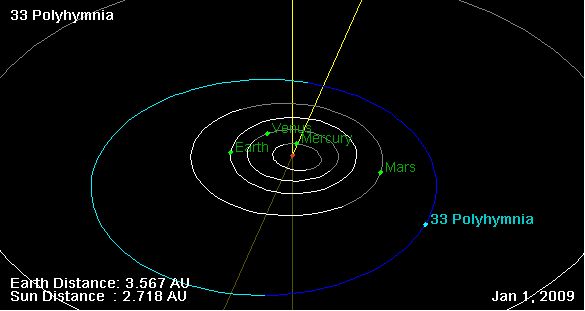Asteroid 33 Polyhymnia likely contains elements outside periodic table
Asteroid 33 Polyhymnia is believed to possess elements that extend beyond the boundaries of the periodic table due to its remarkable density, according to physicists from the University of Arizona in Tucson, the U.S.
This unique density exceeds that of Osmium (pictured below), the densest naturally occurring and stable element with 76 protons on Earth.

The researchers - Evan LaForge, Will Price, and Johann Rafelski – said in a press release that their study, published in the European Physical Journal Plus, proposes to classify 33 Polyhymnia under the concept Compact Ultradense Objects (CUDOs) thanks to its mass density surpassing the established threshold.
While the mass density of this asteroid is above that of familiar atomic matter, yet its composition remains unknown.
More to read:
Asteroid Bennu might have been part of an ocean world
The scientists explored potential elements with atomic numbers (Z) surpassing the highest in the current periodic table.
Although Osmium is the densest stable element, experimental production has yielded elements with higher atomic numbers. Oganesson, for instance, synthesized in 2002, has an atomic number of 118 and is the densest element in the periodic table. However, higher atomic number elements tend to be unstable and possess short lives.
To address the observed characteristics of asteroid 33 Polyhymnia, the team extended their analysis to elements beyond the periodic table, utilizing the relativistic Thomas-Fermi model to estimate mass densities for elements with Z greater than 110.
Despite examining elements within the periodic table, they found no candidates with both high enough mass densities and stability. Instead, they proposed elements in the theoretical island of nuclear stability near Z = 164 as plausible candidates.

33 Polyhymnia's orbit as of early January 2009. Credit: Wikipedia
The team suggested that if a substantial portion of asteroid 33 Polyhymnia were composed of these superheavy metals, it could explain the higher mass density observed. The study's findings lead to the hypothesis that such elements, if stable enough, could exist in the cores of dense asteroids like 33 Polyhymnia.
More to read:
UAE to send spacecraft to Asteroid Belt in search for water
These results are preliminary and need an independent – and practical – confirmation, which might not emerge anytime soon. In the future, however, space probes could take a better look at 33 Polyhymnia and other rocks in the Asteroid Belt and scientists would be able to add new elements to the periodical table.
***
NewsCafe relies in its reporting on research papers that need to be cracked down to average understanding. Some even need to be paid for. Help us pay for science reports to get more interesting stories. Use PayPal: office[at]rudeana.com or paypal.me/newscafeeu.




![[video] Guess who’s hiding more than 8 kilometers below the ocean’s surface?](/news_img/2025/11/13/news0_mediu.jpg)
![[video] Putin rules from shadows: Investigation finds Russian leader rarely works in Moscow](/news_img/2025/11/11/news1_mediu.jpg)

